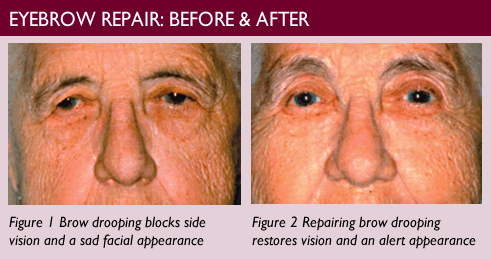Eyebrows
An Open Window
Into Your Emotions!
Heidi Jarecki, MD
Ophthalmology
Chippewa Valley Eye Clinic
Eau Claire
Happy, surprised, melancholy? When it comes to expressing emotions brows tell it all. Eyebrows set the tone for a face and are key conveyors of mood. An appropriately positioned and shaped brow contributes to a pleasant, alert facial outlook, while a droopy or sparse brow conveys tiredness or sadness. Apart from their role in expression, eyebrow position can also influence side vision and apparent eyelid position. Sagging brows are a surprisingly common and often unappreciated cause of side vision loss.
“Eyebrows accomplish their important role in
conveying mood and emotion through
the interplay of several muscles.”
Though many think of eyebrows as just hair, there is more to the brow than first meets the eye. The eyebrow has three parts–head, body and tail–with the head being the most midline and the tail located closer to the temple. Brow shape and position differ considerably in men and women. Generally more full, the male brow sits at the level of the superior orbital rim, the bone above the upper eyelid. In contrast, the female brow is higher, somewhat thinner and arched. Though often subject to the whims of fashion (recall the thick brows of the 1980s Brooke Shields and the pencil thin brows of the 1960s) some generalities hold true with regard to the female brow. The head of the female brow rests at the superior orbital rim. The body arches upward, reaching a highest point directly above the lateral canthus (the corner where the upper and lower eyelid meet) before the tail tapers to a gentle end. Many brows have been optimized to achieve a certain look via tweezing, brow pencils or powders and/or permanent cosmetics (tattooing). All this effort is undertaken because an appropriate brow shape and position gives an awake, attentive and fresh facial appearance.
 Eyebrows accomplish their important role in conveying mood and emotion through the interplay of several muscles. The frontalis muscle covers the forehead and is the only muscle to raise the brow, while several other muscles act to bring the brow down. Over time the combined force of the brow depressors tends to win out over the single brow elevator and drooping or sagging results. Adding to the problem, the frontalis muscle only supports the inner two thirds of the brow. The outermost third, the part most prone to sagging, has no elevating muscle support. This brow droop is known as brow ptosis and is extremely common. Eyebrows sit atop a fat pad which extends up the forehead underneath the frontalis muscle. When the brow and the fat pad droop, they can press down on the lid, blocking side vision.
Eyebrows accomplish their important role in conveying mood and emotion through the interplay of several muscles. The frontalis muscle covers the forehead and is the only muscle to raise the brow, while several other muscles act to bring the brow down. Over time the combined force of the brow depressors tends to win out over the single brow elevator and drooping or sagging results. Adding to the problem, the frontalis muscle only supports the inner two thirds of the brow. The outermost third, the part most prone to sagging, has no elevating muscle support. This brow droop is known as brow ptosis and is extremely common. Eyebrows sit atop a fat pad which extends up the forehead underneath the frontalis muscle. When the brow and the fat pad droop, they can press down on the lid, blocking side vision.
Normally the eyebrow moves independently of the upper lid, but extreme brow raising can elevate the lid somewhat. Extreme brow raising (technically called frontalis recruiting) is a common compensatory behavior that attempts to improve side vision when drooping brows or lids are causing an obstruction. Brow raising lifts the brow fat pad, thereby relieving weight from the upper lid. Often times, brow ptosis goes unnoticed because brow raising becomes habitual. Constant brow raising can cause headaches and a feeling of tiredness in the face and eyes.
Just as extreme brow raising helps elevate the lid and smooth out the eyelid skin, brow drooping causes an appearance of redundant upper lid skin. I have spoken to many patients whose concern is their extra eyelid skin, but the real problem is a saggy brow causing the eyelid skin to bunch together. Fixing the brow position fixes the lid problem.
Repairing brow ptosis uses a variety of approaches. For minor brow ptosis, for which simple cosmetic improvement is sought, well placed Botox® or other like products can be used. For brow ptosis affecting vision or more moderate to severe ptosis, brow elevating surgery is indicated. Incisional options include directly above the eyebrow, through a deep wrinkle in the forehead, through an incision at the hairline or via several small incisions in the scalp through which a small endoscope is used. The approach used depends on a variety of facial characteristics, as well as the purpose of the surgery. Endoscopic approaches may be seen as cosmetic interventions by some insurance carriers. Browplasty surgery is generally outpatient surgery and the most common concerns after surgery are bruising and swelling that generally last one to two weeks.
Eyebrow shape and prominence can be modified in a host of ways: tweezing, brow powders and pencils and tattooing being the more common. Brow tinting can add appropriate color and topical products, like the lash serum Latisse®, hold promise in restoring lost brow hair.
Dr. Jarecki – Chippewa Valley Eye Clinic
For information or to schedule an appointment:
715.834.8471 | www.chippewavalleyeye.com
Dr. Jarecki sees patients in Eau Claire.